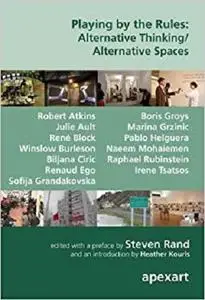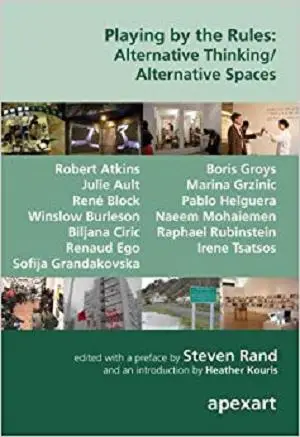Playing by the Rules: Alternative Thinking/ Alternative Spaces by Naeem Mohaiemen
English | ISBN: 1933347430 | 176 pages | EPUB | August 12, 2010 | 0.48 Mb
English | ISBN: 1933347430 | 176 pages | EPUB | August 12, 2010 | 0.48 Mb
The perceived rules of the development and running of alternative spaces, and where those rules came from, are among the questions answered by the authors of Playing by the Rules: Alternative Thinking/Alternative Spaces. The underlying message in the publication is the importance of critical thinking as well as the need for alternative thinking. In the book s preface, Steven Rand (artist and the Founder and Executive Director of apexart) addresses the role of the alternative space and the need for alternative thinking to challenge some of the art world s practices and the ways apexart has tried to address them over the last 16 years. A few of the essays provide some history of alternative spaces. Robert Atkins (art historian, critic, and curator based in California) uses as an example the salons of the 1920s, specifically Mabel Dodge s, to show how a true alternative functioned. René Block (gallerist and former director of the Kunsthalle Fridericianum in Kassel, Germany) gives a brief history of how alternatives began and an introduction to the Berlin space TANAS. Using case studies of art venues in China, Vietnam, and Cambodia over the last 20-30 years, Biljana Ciric (independent curator based in Shanghai) explores the potentials of alternatives. Other essays use other alternatives as example. Irene Tsatsos (writer and curator and former Executive Director of Los Angeles Contemporary Exhibitions) uses examples of permaculture housing as alternative living arrangement and Matta-Clark s restaurant Food as alternative venue in the 1970s to demonstrate the importance of critical thinking and unrestrained creative expression. Marina Grzinic (philosopher, artist and theoretician based in Ljubljana) presents the construction of normality to help define alternative. Naeem Mohaiemen (writer, artist, and technologist working in Dhaka and New York) uses as main example the Paris exhibition of works from Bangladesh to show how an alternative approach to standard procedure is necessary. Other essays reaffirm the importance of thinking critically. Sofija Grandakovska (academic, theorist, and poet in Skopje) uses the dissident, as an example to explore the importance of critical thinking and searches for the alternative space for the dissident. Julie Ault (artist, writer, and editor based in New York) reviews her previous writing on alternative spaces and shares the importance of reflexivity in continually asking what we are doing and why. Winslow Burleson (Assistant Professor of Human Computer Interaction at Arizona State University; received his PhD from the MIT Media Lab) shares his work in the field of Human Computer Interaction to present a series of motivational tools for young people working in the arts today. Some texts reveal ways to achieve a new alternative space. Renaud Ego (poet based in Paris) shows the alternative aspects in the field of writing and mentions technology, specifically the Internet, as a place for free expression. Boris Groys (philosopher, essayist, art critic, media theorist, and professor at New York University) also explores the power of the Internet as he argues that the de-professionalization of art is a highly professional operation and further that weak images have the most power. The future of alternative spaces may lie in a non-venue. Pablo Helguera (artist and Director of Adult and Academic Programs at the Education Department of MoMA, NY) suggests we ought to (re)consider our audience and that perhaps the public program and a traveling venue is a more appropriate approach to reaching current audiences. Raphael Rubinstein (New York-based poet and art critic and past editor at Art in America) reviews some of the changes that have evolved since alternative spaces began in the 1970s. More information: apexart.org/publications/playingbytherules.htm



